child lock PONTIAC VIBE 2010 Owners Manual
[x] Cancel search | Manufacturer: PONTIAC, Model Year: 2010, Model line: VIBE, Model: PONTIAC VIBE 2010Pages: 318, PDF Size: 1.7 MB
Page 1 of 318
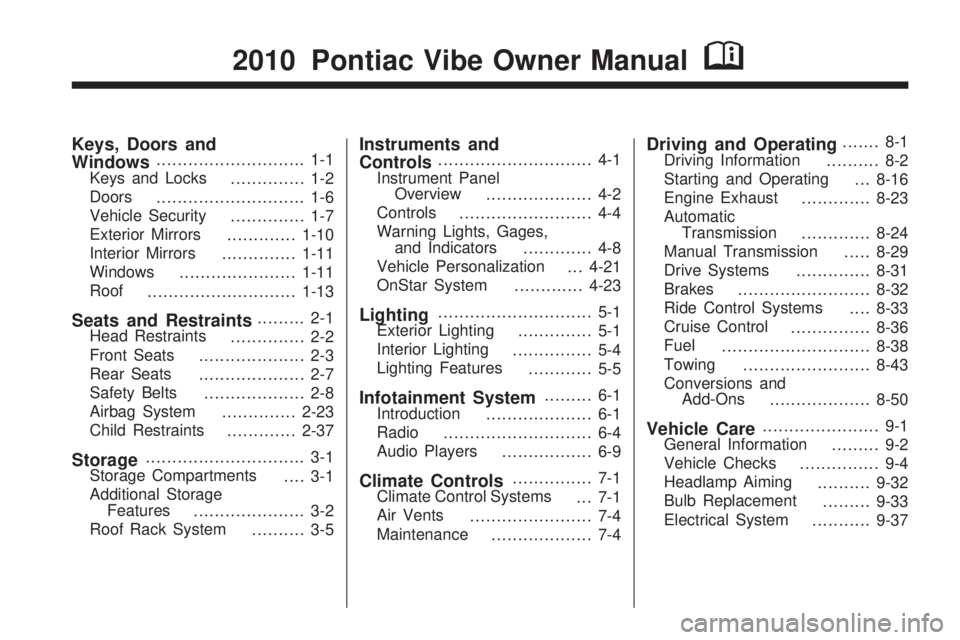
Keys, Doors and
Windows............................ 1-1
Keys and Locks .............. 1-2
Doors ............................ 1-6
Vehicle Security .............. 1-7
Exterior Mirrors .............1-10
Interior Mirrors ..............1-11
Windows ...................... 1-11
Roof ............................ 1-13
Seats and Restraints......... 2-1
Head Restraints .............. 2-2
Front Seats .................... 2-3
Rear Seats .................... 2-7
Safety Belts ................... 2-8
Airbag System ..............2-23
Child Restraints .............2-37
Storage.............................. 3-1
Storage Compartments .... 3-1
Additional Storage Features ..................... 3-2
Roof Rack System .......... 3-5
Instruments and
Controls............................. 4-1
Instrument Panel Overview .................... 4-2
Controls ......................... 4-4
Warning Lights, Gages, and Indicators ............. 4-8
Vehicle Personalization . . . 4-21
OnStar System .............4-23
Lighting............................. 5-1
Exterior Lighting .............. 5-1
Interior Lighting ............... 5-4
Lighting Features ............ 5-5
Infotainment System......... 6-1
Introduction .................... 6-1
Radio ............................ 6-4
Audio Players ................. 6-9
Climate Controls............... 7-1
Climate Control Systems ... 7-1
Air Vents ....................... 7-4
Maintenance ................... 7-4
Driving and Operating....... 8-1
Driving Information .......... 8-2
Starting and Operating . . . 8-16
Engine Exhaust .............8-23
Automatic Transmission .............8-24
Manual Transmission .....8-29
Drive Systems ..............8-31
Brakes ......................... 8-32
Ride Control Systems ....8-33
Cruise Control ...............8-36
Fuel ............................ 8-38
Towing ........................ 8-43
Conversions and Add-Ons ................... 8-50
Vehicle Care...................... 9-1
General Information ......... 9-2
Vehicle Checks ............... 9-4
Headlamp Aiming ..........9-32
Bulb Replacement .........9-33
Electrical System ...........9-37
2010 Pontiac Vibe Owner ManualM
Page 5 of 318
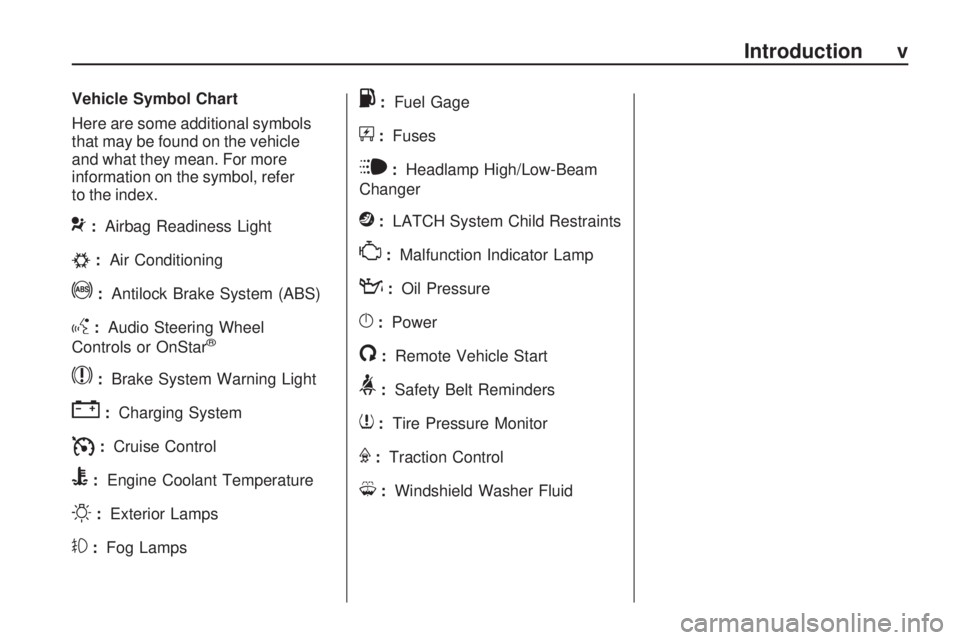
Vehicle Symbol Chart
Here are some additional symbols
that may be found on the vehicle
and what they mean. For more
information on the symbol, refer
to the index.
9:Airbag Readiness Light
#:Air Conditioning
!:Antilock Brake System (ABS)
g:Audio Steering Wheel
Controls or OnStar®
$: Brake System Warning Light
":Charging System
I:Cruise Control
B:Engine Coolant Temperature
O:Exterior Lamps
#:Fog Lamps
.:Fuel Gage
+:Fuses
i:Headlamp High/Low-Beam
Changer
j: LATCH System Child Restraints
*:Malfunction Indicator Lamp
::Oil Pressure
}:Power
/:Remote Vehicle Start
>:Safety Belt Reminders
7:Tire Pressure Monitor
F:Traction Control
M:Windshield Washer Fluid
Introduction v
Page 8 of 318
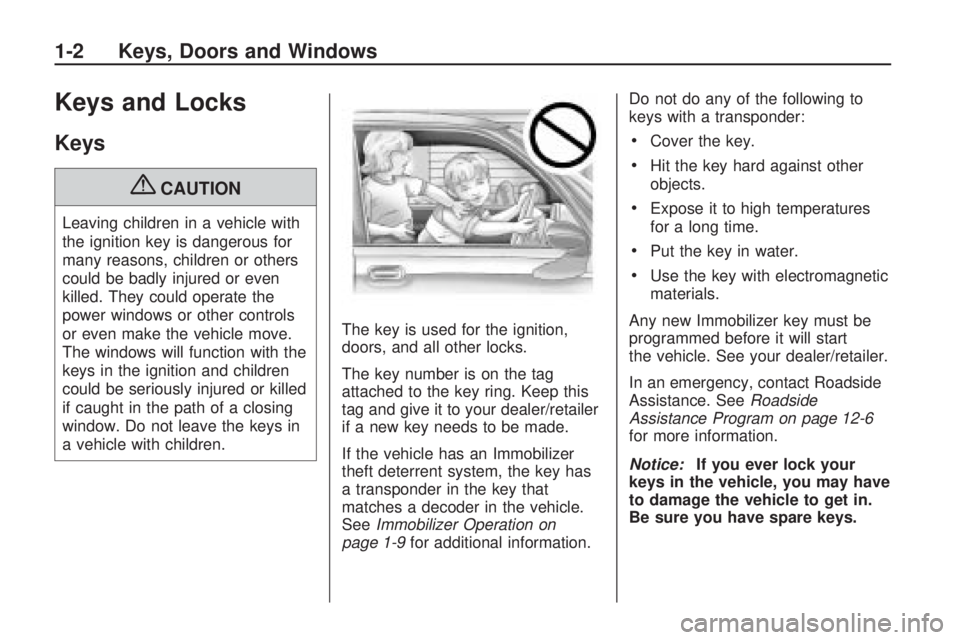
Keys and Locks
Keys
{CAUTION
Leaving children in a vehicle with
the ignition key is dangerous for
many reasons, children or others
could be badly injured or even
killed. They could operate the
power windows or other controls
or even make the vehicle move.
The windows will function with the
keys in the ignition and children
could be seriously injured or killed
if caught in the path of a closing
window. Do not leave the keys in
a vehicle with children.The key is used for the ignition,
doors, and all other locks.
The key number is on the tag
attached to the key ring. Keep this
tag and give it to your dealer/retailer
if a new key needs to be made.
If the vehicle has an Immobilizer
theft deterrent system, the key has
a transponder in the key that
matches a decoder in the vehicle.
See
Immobilizer Operation on
page 1-9 for additional information. Do not do any of the following to
keys with a transponder:
•Cover the key.
•Hit the key hard against other
objects.
•Expose it to high temperatures
for a long time.
•Put the key in water.
•Use the key with electromagnetic
materials.
Any new Immobilizer key must be
programmed before it will start
the vehicle. See your dealer/retailer.
In an emergency, contact Roadside
Assistance. See Roadside
Assistance Program on page 12-6
for more information.
Notice: If you ever lock your
keys in the vehicle, you may have
to damage the vehicle to get in.
Be sure you have spare keys.
1-2 Keys, Doors and Windows
Page 11 of 318
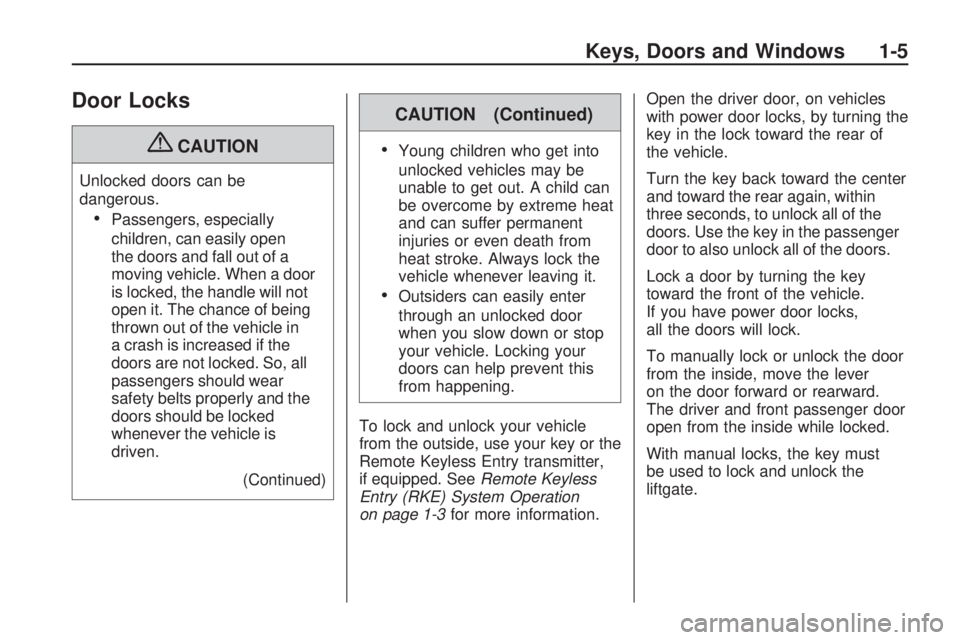
Door Locks
{CAUTION
Unlocked doors can be
dangerous.
•Passengers, especially
children, can easily open
the doors and fall out of a
moving vehicle. When a door
is locked, the handle will not
open it. The chance of being
thrown out of the vehicle in
a crash is increased if the
doors are not locked. So, all
passengers should wear
safety belts properly and the
doors should be locked
whenever the vehicle is
driven.(Continued)
CAUTION (Continued)
•Young children who get into
unlocked vehicles may be
unable to get out. A child can
be overcome by extreme heat
and can suffer permanent
injuries or even death from
heat stroke. Always lock the
vehicle whenever leaving it.
•Outsiders can easily enter
through an unlocked door
when you slow down or stop
your vehicle. Locking your
doors can help prevent this
from happening.
To lock and unlock your vehicle
from the outside, use your key or the
Remote Keyless Entry transmitter,
if equipped. See Remote Keyless
Entry (RKE) System Operation
on page 1-3 for more information. Open the driver door, on vehicles
with power door locks, by turning the
key in the lock toward the rear of
the vehicle.
Turn the key back toward the center
and toward the rear again, within
three seconds, to unlock all of the
doors. Use the key in the passenger
door to also unlock all of the doors.
Lock a door by turning the key
toward the front of the vehicle.
If you have power door locks,
all the doors will lock.
To manually lock or unlock the door
from the inside, move the lever
on the door forward or rearward.
The driver and front passenger door
open from the inside while locked.
With manual locks, the key must
be used to lock and unlock the
liftgate.
Keys, Doors and Windows 1-5
Page 18 of 318
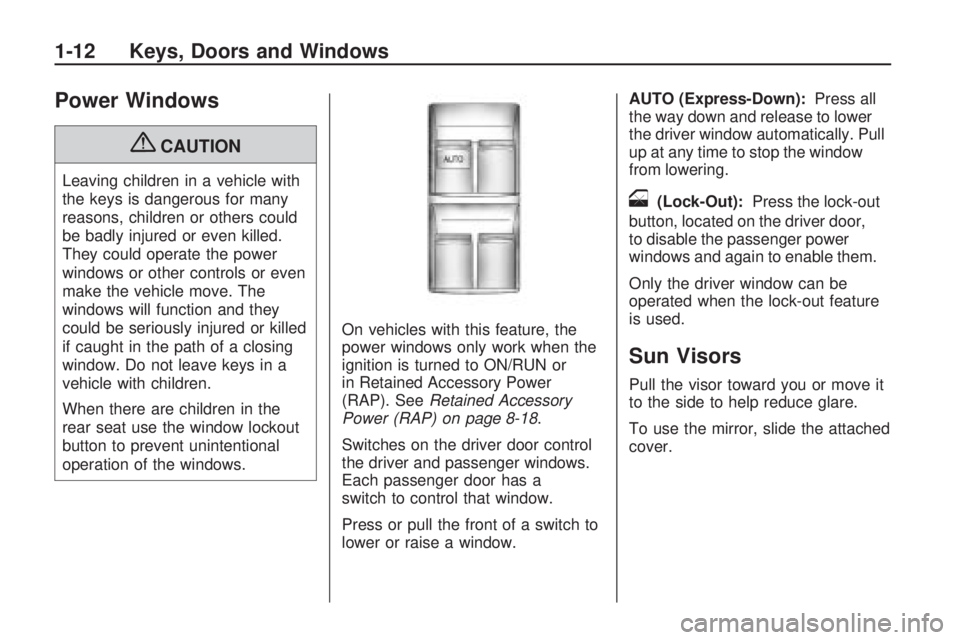
Power Windows
{CAUTION
Leaving children in a vehicle with
the keys is dangerous for many
reasons, children or others could
be badly injured or even killed.
They could operate the power
windows or other controls or even
make the vehicle move. The
windows will function and they
could be seriously injured or killed
if caught in the path of a closing
window. Do not leave keys in a
vehicle with children.
When there are children in the
rear seat use the window lockout
button to prevent unintentional
operation of the windows.On vehicles with this feature, the
power windows only work when the
ignition is turned to ON/RUN or
in Retained Accessory Power
(RAP). See
Retained Accessory
Power (RAP) on page 8-18 .
Switches on the driver door control
the driver and passenger windows.
Each passenger door has a
switch to control that window.
Press or pull the front of a switch to
lower or raise a window. AUTO (Express-Down):
Press all
the way down and release to lower
the driver window automatically. Pull
up at any time to stop the window
from lowering.
o(Lock-Out): Press the lock-out
button, located on the driver door,
to disable the passenger power
windows and again to enable them.
Only the driver window can be
operated when the lock-out feature
is used.
Sun Visors
Pull the visor toward you or move it
to the side to help reduce glare.
To use the mirror, slide the attached
cover.
1-12 Keys, Doors and Windows
Page 38 of 318
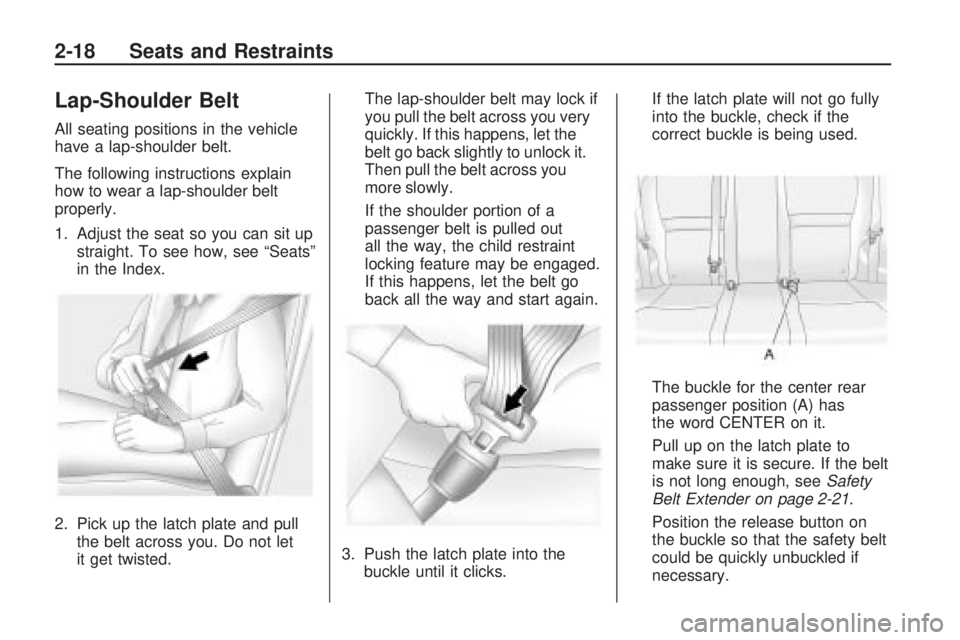
Lap-Shoulder Belt
All seating positions in the vehicle
have a lap-shoulder belt.
The following instructions explain
how to wear a lap-shoulder belt
properly.
1. Adjust the seat so you can sit upstraight. To see how, see “Seats”
in the Index.
2. Pick up the latch plate and pull the belt across you. Do not let
it get twisted. The lap-shoulder belt may lock if
you pull the belt across you very
quickly. If this happens, let the
belt go back slightly to unlock it.
Then pull the belt across you
more slowly.
If the shoulder portion of a
passenger belt is pulled out
all the way, the child restraint
locking feature may be engaged.
If this happens, let the belt go
back all the way and start again.
3. Push the latch plate into the buckle until it clicks. If the latch plate will not go fully
into the buckle, check if the
correct buckle is being used.
The buckle for the center rear
passenger position (A) has
the word CENTER on it.
Pull up on the latch plate to
make sure it is secure. If the belt
is not long enough, see
Safety
Belt Extender on page 2-21 .
Position the release button on
the buckle so that the safety belt
could be quickly unbuckled if
necessary.
2-18 Seats and Restraints
Page 52 of 318

If the airbag readiness light and the
OFF light in the passenger airbag
status indicator come on together,
it may mean there is a malfunction
in the passenger sensing system.
Secure the child in the child restraint
in a rear seat position in the vehicle
and check with your dealer/retailer.
{CAUTION
If the airbag readiness light ever
comes on and stays on, it means
that something may be wrong with
the airbag system. To help avoid
injury to yourself or others, have
the vehicle serviced right away.
SeeAirbag Readiness Light on
page 4-12 for more information,
including important safety
information.
If the On Indicator is Lit for a
Child Restraint
If a child restraint has been installed
and the on indicator is lit:
1. Turn the vehicle off.
2. Remove the child restraint from the vehicle.
3. Remove any additional items from the seat such as blankets,
cushions, seat covers, seat
heaters, or seat massagers.
4. Reinstall the child restraint with the ignition key in the ACC or
LOCK position while following the
directions provided by the child
restraint manufacturer and refer
toSecuring Child Restraints
(Rear Seat Position) on
page 2-51 orSecuring Child
Restraints (Right Front Seat
Position) on page 2-53 .5. If, after reinstalling the child
restraint and restarting the
vehicle, the on indicator is still lit,
turn the vehicle off. Then slightly
recline the vehicle seatback
and adjust the seat cushion, if
adjustable, to make sure that the
vehicle seatback is not pushing
the child restraint into the seat
cushion.
6. Also make sure the child restraint is not trapped under the vehicle
head restraint. If this happens,
adjust the head restraint.
See Head Restraints on
page 2-2.
If the on indicator is still lit, secure
the child in the child restraint in
a rear seat position in the vehicle,
and check with your dealer/retailer.
2-32 Seats and Restraints
Page 68 of 318
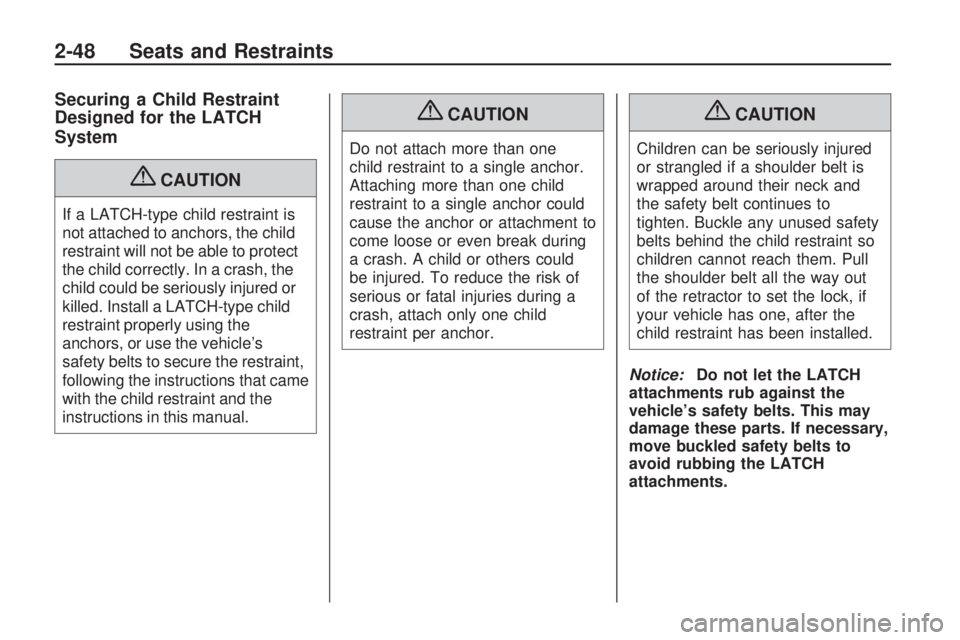
Securing a Child Restraint
Designed for the LATCH
System
{CAUTION
If a LATCH-type child restraint is
not attached to anchors, the child
restraint will not be able to protect
the child correctly. In a crash, the
child could be seriously injured or
killed. Install a LATCH-type child
restraint properly using the
anchors, or use the vehicle’s
safety belts to secure the restraint,
following the instructions that came
with the child restraint and the
instructions in this manual.
{CAUTION
Do not attach more than one
child restraint to a single anchor.
Attaching more than one child
restraint to a single anchor could
cause the anchor or attachment to
come loose or even break during
a crash. A child or others could
be injured. To reduce the risk of
serious or fatal injuries during a
crash, attach only one child
restraint per anchor.
{CAUTION
Children can be seriously injured
or strangled if a shoulder belt is
wrapped around their neck and
the safety belt continues to
tighten. Buckle any unused safety
belts behind the child restraint so
children cannot reach them. Pull
the shoulder belt all the way out
of the retractor to set the lock, if
your vehicle has one, after the
child restraint has been installed.
Notice: Do not let the LATCH
attachments rub against the
vehicle’s safety belts. This may
damage these parts. If necessary,
move buckled safety belts to
avoid rubbing the LATCH
attachments.
2-48 Seats and Restraints
Page 72 of 318
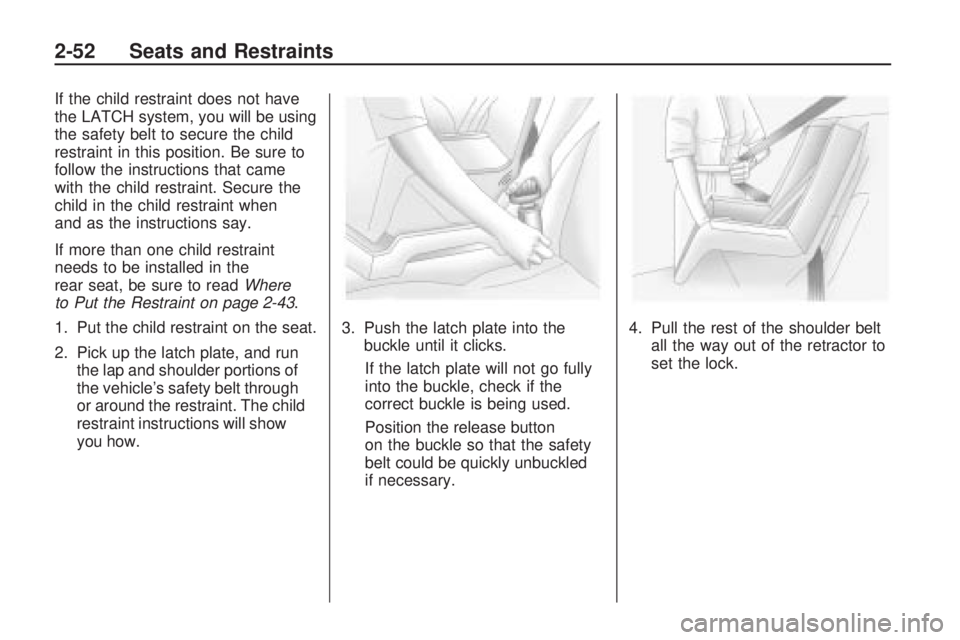
If the child restraint does not have
the LATCH system, you will be using
the safety belt to secure the child
restraint in this position. Be sure to
follow the instructions that came
with the child restraint. Secure the
child in the child restraint when
and as the instructions say.
If more than one child restraint
needs to be installed in the
rear seat, be sure to readWhere
to Put the Restraint on page 2-43 .
1. Put the child restraint on the seat.
2. Pick up the latch plate, and run the lap and shoulder portions of
the vehicle’s safety belt through
or around the restraint. The child
restraint instructions will show
you how. 3. Push the latch plate into the
buckle until it clicks.
If the latch plate will not go fully
into the buckle, check if the
correct buckle is being used.
Position the release button
on the buckle so that the safety
belt could be quickly unbuckled
if necessary. 4. Pull the rest of the shoulder belt
all the way out of the retractor to
set the lock.
2-52 Seats and Restraints
Page 75 of 318
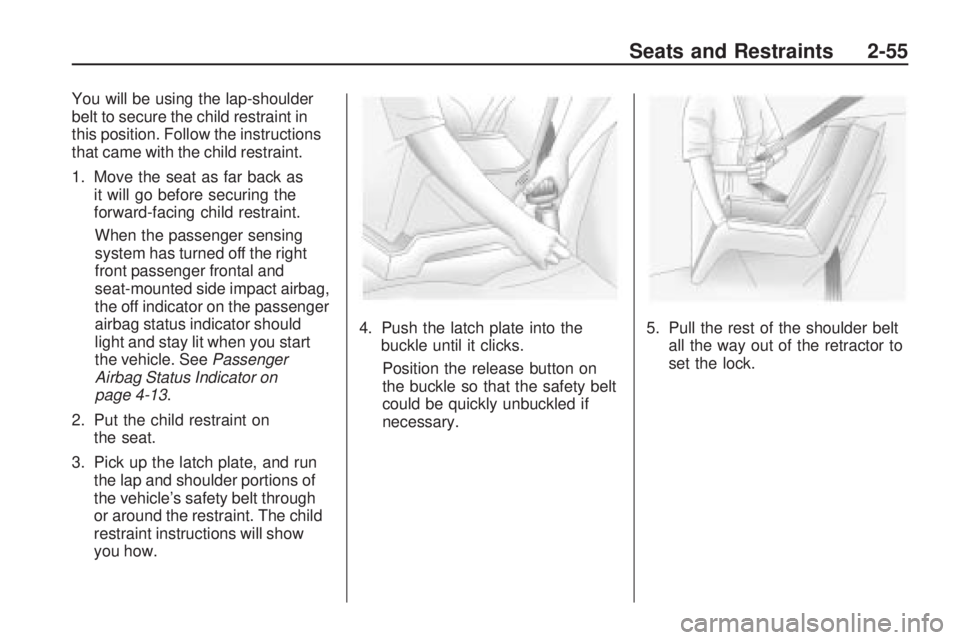
You will be using the lap-shoulder
belt to secure the child restraint in
this position. Follow the instructions
that came with the child restraint.
1. Move the seat as far back asit will go before securing the
forward-facing child restraint.
When the passenger sensing
system has turned off the right
front passenger frontal and
seat-mounted side impact airbag,
the off indicator on the passenger
airbag status indicator should
light and stay lit when you start
the vehicle. See Passenger
Airbag Status Indicator on
page 4-13.
2. Put the child restraint on the seat.
3. Pick up the latch plate, and run the lap and shoulder portions of
the vehicle’s safety belt through
or around the restraint. The child
restraint instructions will show
you how. 4. Push the latch plate into the
buckle until it clicks.
Position the release button on
the buckle so that the safety belt
could be quickly unbuckled if
necessary. 5. Pull the rest of the shoulder belt
all the way out of the retractor to
set the lock.
Seats and Restraints 2-55